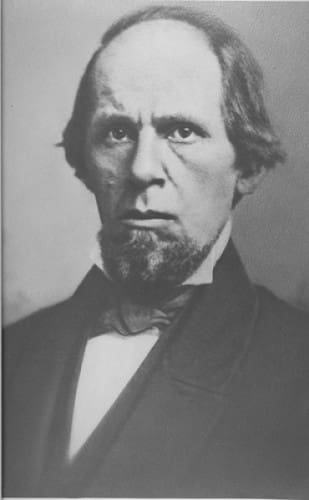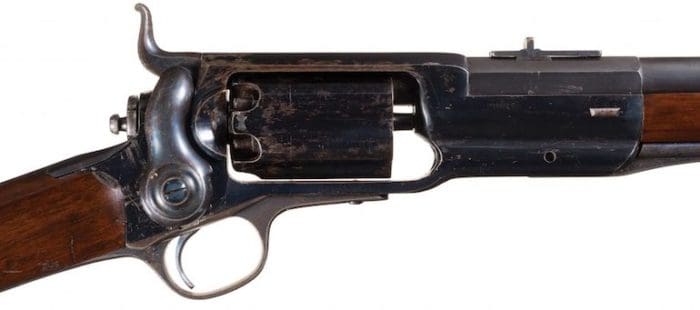From rockislandauctions.com: Most of us have seen a Colt “Sidehammer,” but few have had the pleasure of seeing a fully stocked Sporting Rifle. These sidehammers (in all their forms) also go by the nickname “Root” thanks to the involvement of one Mr. Elisha K. Root, who was instrumental to the early success of Colt Manufacturing . . .
He was a renowned machinist before joining Colt as its Chief Mechanic in 1849 and bringing his precision machining tools with him. He would go on to become Superintendent and allegedly the highest salaried person in the state as Colt had to best several lucrative offers from other companies.
Root improved almost everything that could be improved once beginning his work at Colt. His patents include: a compound rifling machine for rifling four barrels at once instead of one, a machine for boring chambers in revolver cylinders, the slide lathe, three patents for making cartridges, one patent for packaging them, a better way to shape pistol stocks, improving the machine used to pump water into the Armsmear reservoir, and some steam-engines that Colt manufactured for the Russian government.
Root even served as one of Colt’s eight pallbearers at his 1862 funeral and then served as president of Colt Manufacturing until his own death on July 5, 1865.
These rare revolving rifles have much in common with their other sidehammer brethren (the revolvers, military rifles, half stock Sporters, shotguns, and carbines), though it was the design and balance of the full and half stock Sporting rifles that made them a preferred presentation piece of Samuel Colt.
Known specimens have been presented to the aforementioned Mr. Root, Secretary of War John B. Floyd, the Major and Second Kings of Siam, as well as members of the Russian Imperial Court. Needless say, these were highly valued weapons back then and an absolute treasure to collectors today.
Of all the Model 1855 Sporting Rifles manufactured in .44 cal from 1855-1864, only 250 have 24″ barrels like this one. Most of the sporting rifles are half stock models, approximately 1,000 – 1,5000, while the full stocked Sporting Rifles are thought to number around… well, no one knows.
The Book of Colt Firearms lists their number as “limited,” while Colt: An American Legend doesn’t list a production number at all – instead erring on the side of caution to say that only 18,300 long guns of all types were produced. In any case, they are a rare find made even rarer still with the presence of its case and accessories. These are classified by TCBF as “the utmost rarity.”







How effective could a 24 inch revolver be??
Looks like more of a novelty then a for real firearm.
Like a Buntline if they were still made I guess.
A 45 inch Colt. I don’t need one.
In any event if made today it might make a nice range toy if nothing else.
“How effective could a 24 inch revolver be??”
If a company could incorporate a gas sealing mechanism like the Nagant M1895 revolver, I’d say about as effective as a modern lever-action carbine.
In other words, probably just fine.
On a related political note, if the ‘Grabbers’ ever outlaw mag-fed rifles, I could easily see a modern resurgence in cylinder-rifles, since a 10 round or so cylinder wouldn’t be unmanageable in a rifle…
Rossi has a series like that in centerfire & rimfire.
But it doesn’t seal the chamber, and you get blast in your face.
When it was made I’d say it was about 5 times for effective than the other rifles of the day.
If one were a combattant of the War for the Union and one’s opponents had just fired a volley and were then reloading their single shot frontloaders (1861 Springfield, et. al. ), those other five shots of yours may seem to be rather ‘practical’, indeed. Those on the receiving end would have found it to be quite ‘real’ and far from being a ‘range toy’.
I’ll take two.
i want to shoot dirty ammo through it and then have it confiscated.
and let my nephews play with the box.
I thought a few years ago Dixie Gun Works introduced a replica Root revolving +rifle in .56 cal, but I didn’t see it in their 2017 catalog. Anybody remember it?
DGW has sold the 1858 Remington revolving percussion carbine for years. The problem with revolving carbines is that the supporting hand must be kept to the rear of the cylinder/barrel join, or the side-blast gases from a discharge would scorch that hand or arm. From my reading, I learned that before the Civil War, the U.S. Marine Corps bought some Root rifles for Marines assigned to ship guard detachments, and the rifle was unpopular because of the side-blast issue.
The real danger from these guns was far more than just ‘side-blast’ from the cylinder/breech gap; It was the very serious risk of having the off-side hand and forearm noisily and bloodily punctured, if not removed entirely, by one or more of the other cylinder bores NOT aligned with the barrel discharging along with the intended one, if that arm and hand was holding the forearm.
These were cap-and-ball guns; The big-bore versions were loaded with immense powder charges of 50~60 grains, the same as a military musket. Just as with revolving pistols of the time, the possibility of overwash at the forward end of the cylinder of flame from bore to bore, or concussion or flash leakage from a badly-fitted percussion cap jumping to the next one at the back was very real.
Also, corrosion between bores could take place rapidly, and pinholes could follow–pinholes big enough to allow flame from one bore to go into the next.
The difference between a cap-and-ball pistol, and a rifle, was simple: One didn’t stick one’s left hand and arm forward of the front of the cylinder with a revolver. Thus, if one or more extra charges fired occasionally, the revolver just jammed or came apart. The rifle or shotgun, however, shot you in the arm and/or the hand holding the forearm. THEN it jammed or came apart.
Now, this didn’t happen ALL of the time–just often enough to make people leery of the things.
Thus the striking unpopularity of revolving percussion rifles.
Why is there a dildo in the box? Maybe I should rephrase that, what is the object in the case to the right of the sling?
That’s a leather powder flask. There’s also a ball/bullet mold with sprue cutter, a couple of cap tins, probably a grease tin, an oil bottle (I think), a nipple wrench/screwdriver, and under the two lids are cleaning patches and tow. Usually.
Jacobs Munitions! “If it took more than one shot, you weren’t using a Jakobs!”
This is a cool rifle. Look at the Taurus Circuit Judge. I also have some of the bullets used in this that I found metal detecting down here in Alabama. Revolving rifle, I’d buy one!
That, motherfuckers, is packaging.
The last new gun I bought came rattling around in a cardboard box, wrapped in plastic. The only accessories in the box were the user manual and warranty registration card.
That is a fitted case, once rather common among fine custom sporting arms.
They can still be acquired. They aren’t often included with a mass produced, low cost firearm.
Comments are closed.